Everyone wants a cheap car insurance premium, yet so many drivers don’t know how to lower their car insurance because they don’t consider their own habits. The fact is, you can reduce your car insurance in many ways you enact specific measures and ask the right questions.
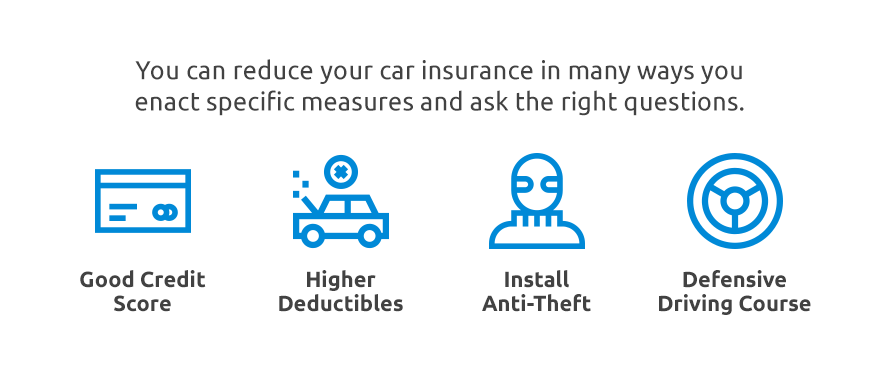
When you apply for an insurance policy, the insurer will run a check on your credit history to get a clearer picture of your financial reliability. As such, your credit score can affect your insurance premiums. Consequently, you will generally qualify for lower premiums if you maintain a good credit score.
Insurers favor applicants with good credit because vehicle owners in that category tend to be responsible for the lowest number of claims. To get and stay within that category, pay down your credit balance, stay on top of your billing cycles and never obtain more credit than necessary. Check your credit score periodically and take immediate action on any incorrect information that appears on your record.
Before you receive funds to cover your expenses when you file a claim, you’re asked to pay an insurance deductible. Most vehicle owners pay high insurance premiums with low deductibles. Insurers, however, will usually offer lower premiums to drivers who opt for higher deductibles instead.
With a typical policy, for example, you might pay a $200 deductible at the time that you file a claim. If you raise that deductible to $400 or $500, you could easily lower the cost of your coverage by anywhere from one-fifth to one-third of what you currently pay for car insurance.
As long as your profile is favorable, you may be able to qualify for lower premiums if you install anti-theft devices in your car. Some of the most useful devices include flashers and beepers, which serve as warnings to anyone who approaches your car that a sound will go off if they touch the vehicle. On the other hand, a club will generally prevent vehicle theft but won’t necessarily deter burglaries of car stereo equipment.
Drivers who use anti-theft devices are often attractive in the eyes of insurers because the vehicles in question are less likely to be burglarized or stolen. As such, fewer claims are likely to be filed by such applicants.
You may be able to get a discount on your insurance premiums if you enroll in a defensive driving course. When you take such a course, it demonstrates a willingness on your part to master driving methods that are safer and more responsible than the typical driver.
A lion’s share of claims filed within a given year is due to accidents that stem from simple human errors, like momentary speeding, attention loss and inertia. The driver who cuts past cars in an effort to speed up their commute puts numerous drivers at risk and could ultimately be an insurance drain if and when an accident occurs. Once you have received your certificate from a defensive driving course, you will be more consciously averse to driving mistakes and alerted to the motorists that drive recklessly.
Friends and relatives can give you pointers on how to shop for car insurance. But you should also shop around as much as possible. Here are five ways to find the best auto insurance plan for you.
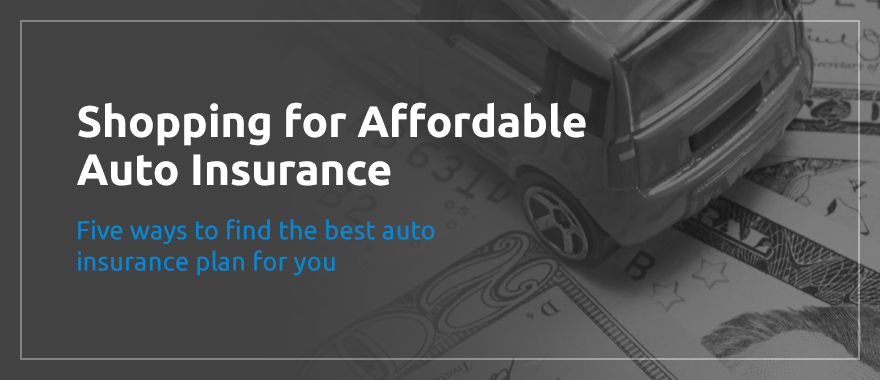
Insurance rates can vary between one company and another. Some companies advertise super-low premiums without mentioning the fact that such rates only apply in extremely rare cases. Other companies will advertise more realistic quotes but will also offer discounts if certain conditions are met.
To gather three or more quotes, run a Google search on car insurance companies in your area. Pull up a list of the companies located nearest to you and contact each one by phone or on their websites. Alternately, you can visit the offices of these companies and speak with insurance agents in person. You may even be able to get a list of price comparisons on the larger insurers from your state insurance department.
Even though a basic policy will have you legally covered, you will not have a truly solid plan unless your insurer is financially stable. To verify a given company’s financial health, check the insurer’s rating at A.M. Best and Standard & Poor’s.
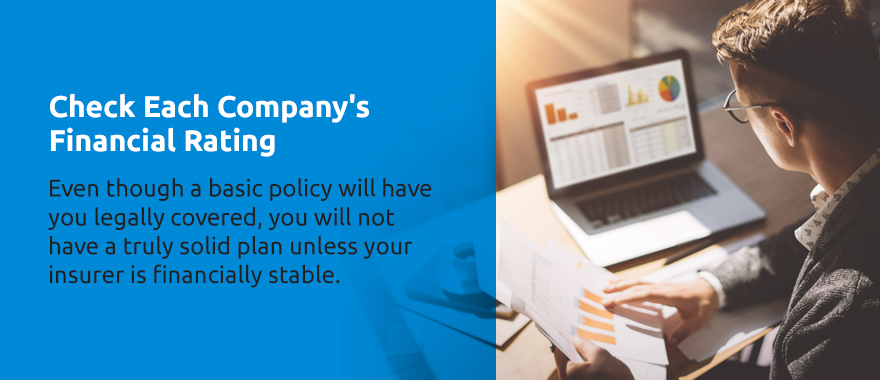
Car insurance companies operate in several different ways. Some sell insurance policies through agents, who court applicants on behalf of a given company. Meanwhile, independent insurance agents sell policies from several different companies at once. Other companies do not use agents and deal with customers directly, either in person or over the phone. Try to get quotes from two or more types of insurance companies to get an idea of which will offer the best deal.
Ask your relatives, friends and work colleagues about their car insurance policies. Keep in mind that some of these people will likely be happier than others about the premium rates per coverage levels in question. If you learn that someone you know has secured a great deal on car insurance, ask about the company and what they needed to qualify.
You can also find out information on local insurers from your state insurance department, which will usually have details on the companies registered in your area. You can use such resources to weed out insurance companies with customer complaints.
Insurance premiums are partially based on the price of an automobile. If you’re in the market for a new or used car, consider the premiums you’re bound to pay for the make and model in question. Speak with the dealer or person selling the vehicle and get quotes from your local insurance companies to get a more solid idea.
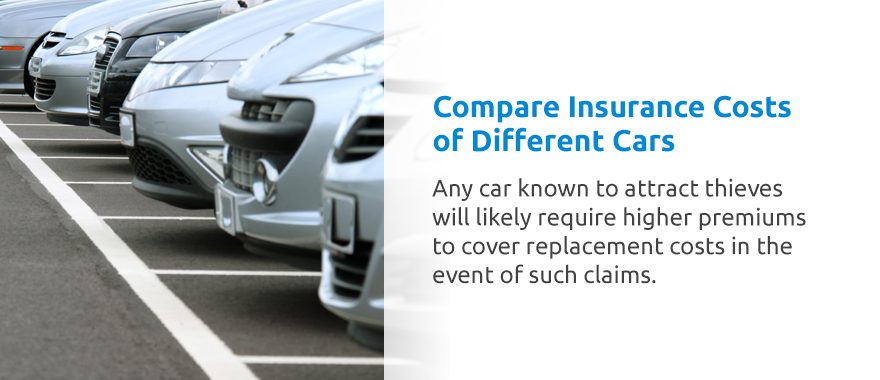
Insurance premiums are also partially based on the average repair costs and general safety record of a given vehicle. The vulnerability of a particular make and model for theft is another factor that insurers keep in mind. Any car known to attract thieves will likely require higher premiums to cover replacement costs in the event of such claims.
Motorists often search in vain for lower car insurance but fail to take note of numerous determining factors. Like millions of drivers, you may have asked “why is my car insurance so high?” during numerous discussions with prior insurers. If you’re wondering how to lower your auto insurance, consider these 10 possibilities.
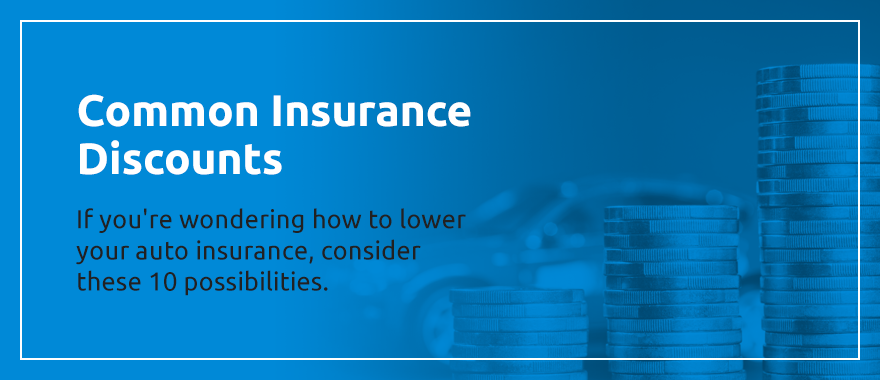
If you drive an older car, the value of the vehicle might not merit an insurance policy beyond the basic liability coverage. For example, if the cost of repairs in light of an accident would exceed the expense of replacing the vehicle with a similar make and model, the car might not be worth the price of a collision or comprehensive policy.
If you purchased the car used and abused for only a few hundred dollars, keep the coverage limited to the minimum amount required by law. If you’re unsure about the value of your vehicle, research the general market worth of the make and model in Kelley’s Blue Book.
You can often get lower car insurance when you bundle the policy with two or more vehicles. On a similar note, you can often get lower premiums if you buy two types of coverage from the same provider. If a company offers car insurance and homeowners insurance, ask if you can get a reduction on each if you purchase both at once.
Of course, you might find that it saves to buy different policies from different providers. That’s why it’s always important to shop around and compare different insurance providers until you find the most satisfying, cost-effective options.
With some insurance companies, you can secure lower premiums if you keep your annual mileage down to a minimum. For example, if your commuting consists of less than 100 miles per week, some insurers will favor you for lower premiums — especially if most of the applicants in your area notch up 100 miles during an average day.
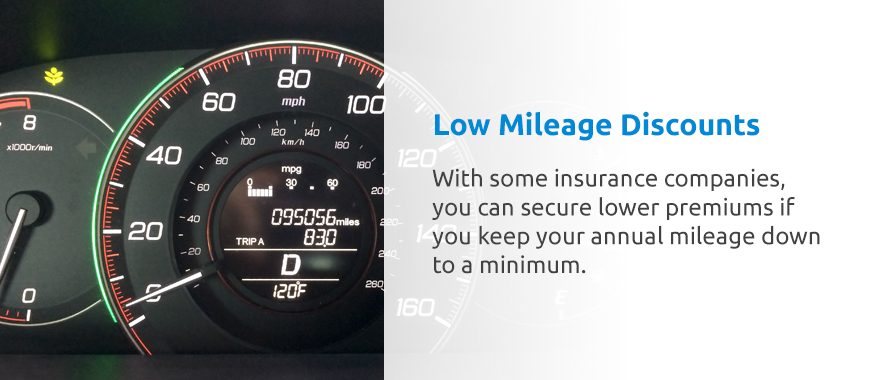
Certain insurers also offer discounts for low mileage to applicants who participate in carpools. If you and your work colleagues take turns with transportation honors during each week, you all might be able to secure lower insurance premiums.
As with healthcare coverage, you can sometimes get car insurance through an employer. If you work for such a company, ask if they have a group insurance plan through which employees can get lower premiums. Group premiums are typically lower because the odds of a claim are relatively low in proportion to the money that goes into the policy.
You can also find lower insurance premiums as a member of certain alumni and business groups. If you belong to any group or club, inquire about group insurance programs that offer lower premiums.
Insurance providers will usually offer discounts to drivers who maintain clean records across a long span of time. Car insurance rates tend to go back down three to five years after you’ve had an accident. If your driving record has been free of blemishes for three years or more, ask your insurance provider if you qualify for lower premiums.
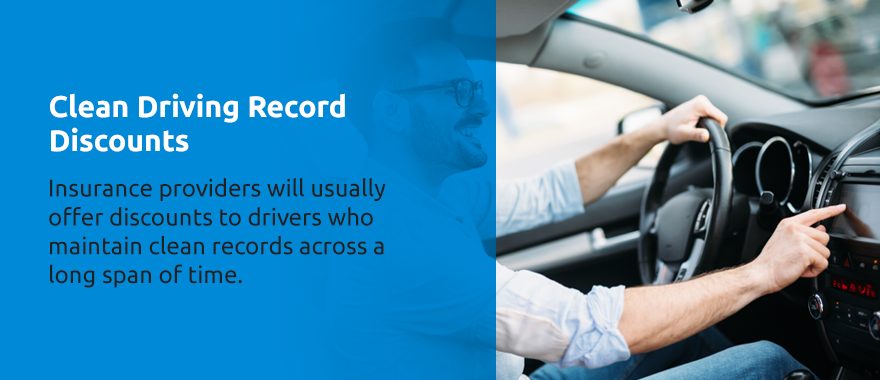
If you’re on the lookout for a new policy, make a note of your clean driving record each time you speak with an insurer. To fit into this category, you will need to have a record free of towing incidences, speeding tickets and accidents for several years.
Some insurers may offer you a discount on your premiums if you agree to enroll in a driver’s education course to brush up on your skills.
Even though driving becomes second nature once you’ve learned the skill and earned your license, you can develop habits over time that might be slightly unsafe or damaging to your vehicle over time. For example, some drivers develop habits such as careening over speed bumps and cutting corners too fast. Such habits can be risky, as well as damaging to the underside components of your vehicle. With a refreshed driver’s education, you can recognize and ultimately curb such habits.
If you’ve been with the same insurance company for a long time, you might qualify for lower car insurance. Of course, this will mostly depend on whether you’ve been an upstanding policyholder throughout the years you’ve been with the company.
If throughout your time with your current insurer, you have never been involved in a collision, bumped or dented another vehicle, been cited for any driving infractions or received any speeding or parking tickets, you might qualify for lower premiums. Even if you do have one or two such incidences on record, you might still be eligible if a number of years have passed since the last infraction.
Younger motorists generally receive high insurance premiums because insurance companies view them as a high-risk demographic among drivers. Drivers in their late teens and early 20s are more likely to drive irresponsibly than their 30-something and older counterparts.
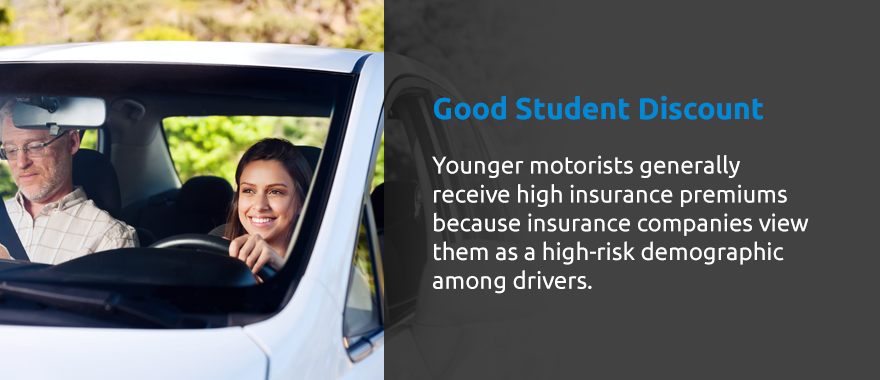
In all fairness, some younger drivers do put safety first when they get behind the wheel. If you’re a younger driver with exceptionally safe and defensive driving habits, provide evidence to your insurer when you ask about lower premiums. Bonus points in the eyes of some insurers may include good grades, a high-grade point average, a clean driving record, a good credit score and low annual mileage.
Cars are rated on a model-by-model basis for their safety. The rating of a given make and model will partially determine the premiums insurance companies will set for the vehicle. The safety rating is based on several factors, such as the likelihood of the car to be involved in an accident and the general cost of repairs for the car’s components.
Newer makes and models are mostly equipped with more high-tech safety features, including advanced headlights and lane-departure alerts. Even though these features have made it safer to drive in newer vehicles, these tools are costly to repair and have led to an increase in insurance premiums.
With so many claims to process in a given month, insurance companies prefer to get their money sooner rather than later. To that end, insurers will often give you a discount if you pay your premiums in-full in advance of each due date. For example, if you pay the following month’s premium five days before the start of the new month, you might be able to secure of discount of anywhere from five to 10 percent off the standard rate.
While we don’t like to think it will happen to us, it can. If you’re ever involved in an accident, follow these six steps.
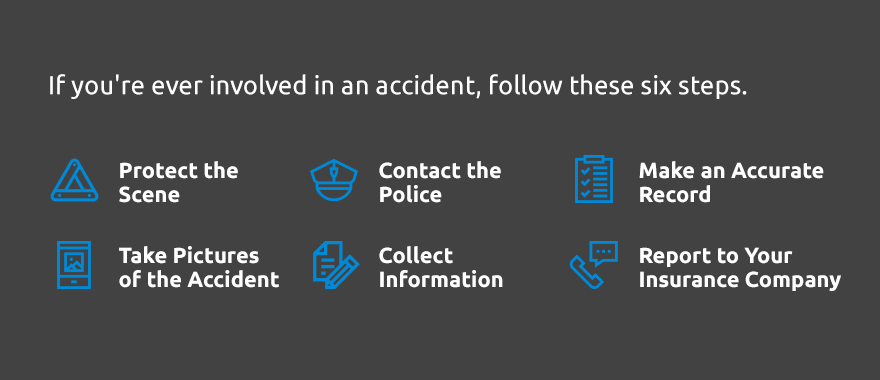
In the event of a crash, the first thing to do is protect the scene and set up barriers to prevent further cars from becoming involved. If the accident occurs in the dark and the lights on your vehicle have been destroyed, use a flashlight to keep the area lit while you wait for help to arrive. Possibilities like these are among the reasons you should always keep a flashlight in your glove compartment.
Regardless of whether any of the parties involved in the accident have sustained injuries, contact the authorities immediately. You will generally need to have a police report on the crash when you contact your insurance provider to file a claim. For the sake of accuracy in the police report, leave the vehicles in their stopping place unless they obstruct traffic.
Make sure all statements on the police report are entirely accurate to the best of your knowledge. If you’re uncertain about the exact cause of the accident or the extent of the damage to your vehicle, just say you’re uncertain — do not make speculations or inaccurate statements. All involved motorists should maintain accuracy without speculation when filing a police report.
In the event of an accident that leaves you unsure about the state of your physical health, do not make any speculations as to whether or not you’re injured — just state that you are unsure. In many cases, any minor injuries that occur due to a car collision will only surface hours after the time of impact.
If possible, take pictures of your vehicle and the other vehicles involved to capture a visual record of the damage. You should also keep a photographic record of any injuries you sustained in the accident. For these purposes, it’s always wise to have a camera or smartphone on-hand.
Even though it’s the police officer’s job to obtain information about the facts and contact info of all parties involved in an accident scene, there are some scenarios where an officer either cannot or do not arrive. If so, gather the vehicle, driver’s license and insurance info of the other motorists involved in the accident. If there are any witnesses at the scene, get their contact info, too.
If and when the police arrive, they will issue a police report number, which you can use at a subsequent date to access the police report.
Immediately following the police reports, record-gathering and scene clearance, report the accident to the insurance company for the party at fault. Be sure to not apologize or claim any fault at the scene of the accident or with the other insurance company. Let the claims adjuster and police department determine the accident’s verdict and party at fault. If you sustain injuries in an accident, ask your insurer whether your medical costs are accounted for in your coverage. With most policies, medical costs are covered under an optional, additional expense referred to as “medpay.”
For responsible drivers, Dave Pope Insurance is a leading provider of car insurance in Missouri. We offer some of the lowest car insurance rates in the state for safe drivers, as well as discounts to motorists with clean records of three years or more. We also offer additional discounts on local auto insurance for drivers who remain accident-free for five years. We even provide defensive driving and bundled policy discounts.
At Dave Pope Insurance, we’re committed to making the driving experience safe and hassle-free for responsible drivers in Missouri. We are based in Union, St. Clair and Washington, MO, and our coverage extends throughout Missouri, Arkansas, Iowa, and Kansas. Upload your current car insurance policy, and we can find out if you are overpaying. Call today at 636-583-0800.